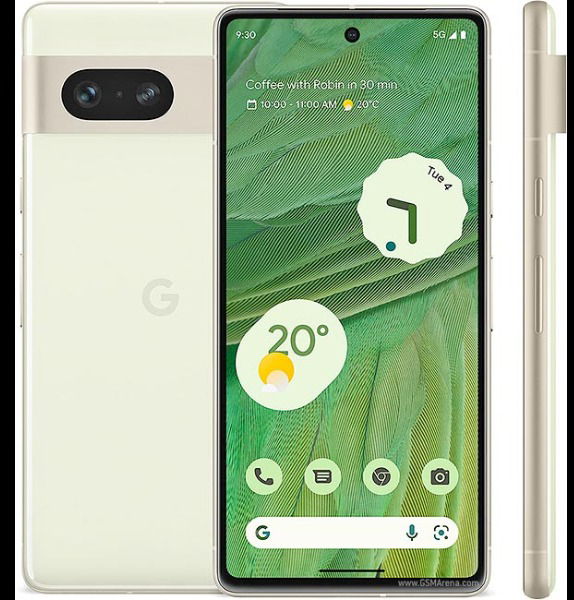


The Google Pixel 7 launched in late 2022, and it’s still a solid contender in the smartphone market. If you’re a fan of clean Android, love taking photos, or need reliable software updates, the Pixel 7 hits the mark.
I have used it daily for months and I’ve had the chance to test its performance, camera, and battery life. Here’s a deep dip into its specifications, key features, and what makes it stand out—or not.
|
Category |
Details |
|
Release Date |
October 13, 2022 |
|
Weight |
197g |
|
Dimensions |
155.6 x 73.2 x 8.7 mm |
|
Build |
Gorilla Glass Victus (front and back), aluminum frame, IP68 water and dust resistance |
|
Display |
6.3-inch AMOLED, 1080x2400 pixels, 90Hz refresh rate, HDR10+, 1000 nits (HBM), 1400 nits (peak) |
|
Processor |
Google Tensor G2 (5 nm) |
|
RAM |
8GB |
|
Storage Options |
128GB, 256GB (UFS 3.1) |
|
Rear Camera |
50MP (wide), 12MP (ultrawide), OIS, 4K video recording |
|
Front Camera |
10.8MP (ultrawide), 4K video recording |
|
Battery |
4355 mAh, 20W wired charging, 20W wireless charging, reverse wireless charging |
|
Operating System |
Android 13, upgradeable to Android 15 |
|
Connectivity |
Wi-Fi 6E, Bluetooth 5.2, NFC, 5G |
|
Colors |
Obsidian, Lemongrass, Snow |
|
Price |
Starting at $232 |
Pros
Cons
1. Google Tensor G2 Chip
The Tensor G2 processor isn’t just a marketing term—it’s the engine behind the Pixel 7’s smooth experience.
I’ve run a variety of apps, from social media to graphic-heavy games, and while it handles most things seamlessly, gaming performance can stutter at times. It’s not quite Snapdragon-level, but the G2 makes everyday use fast and snappy.
2. Camera
If you’re after a camera that just works, the Pixel 7 is where it’s at. The 50MP main camera captures detailed shots, and Google’s computational photography does wonders. Even if a shot looks mediocre before hitting the shutter, the final result often surprises.
I’m a big fan of the Magic Eraser feature—it can remove unwanted objects, though it struggles in complex scenes. Night shots? Simply stunning. Videos, however, are still where the Pixel 7 doesn’t match up to the iPhone. They’re good but need ample lighting to shine.
3. Display
The 6.3-inch AMOLED display is sharp and colorful, but its brightness could use a boost. I sometimes found myself squinting in the outdoors.
The 90Hz refresh rate keeps things smooth, and HDR support means watching videos is a pleasure.
4. Battery Life and Charging
The 4355mAh battery provides decent performance. During light use, the phone easily lasts the whole day, but with heavier tasks (gaming, GPS), it drains faster.
Adaptive Battery helps, and over time, I noticed it adjusting to my usage patterns, extending life just a bit more. Charging isn’t Pixel 7’s strong suit—20W wired charging is fairly slow compared to other devices offering 40W or more. Wireless charging is convenient, but also not the fastest.
6. Build and Design
The Pixel 7 doesn’t feel overly flashy, but it’s solid and practical. The Gorilla Glass Victus front and back make it more durable than many competitors in its price range.
The IP68 rating means it can survive accidental spills. I’ve dropped mine a couple of times, and it’s held up fine. The design is simple, but that’s part of its charm—no unnecessary bells and whistles, just functionality.
The Google Pixel 7 remains a great choice for those who want the best experience without the high price tag. Its standout camera performance and clean Android software continue to impress.
While there are areas where it falls short (charging speed, video quality), it delivers in all the right places. The Pixel 7 may not be the flashiest phone out there, but it’s a solid, dependable device with Google’s best software integrations.
The overall rating is based on reviews by our experts
No reviews yet
|
How Is the Design? |
|
|
How is the Display? |
|
|
How is the Camera? |
|
|
How are the Features? |
|
|
How is the Connectivity |
|
|
How is the Usability? |
|
|
How is the Performance? |
|
|
How is the Battery Life? |
No prices available